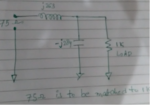himanshul
Newbie level 5
Hi friends,
I went through this extremely helpful and informative thread.... post 3.... and knew about the physical significance of imaginary part of the impedance.
Here I am presenting a circuit which is an L network used for matching.On simplifying the circuit the equivalent circuit is shown below.
Now the text says that in the equivalent circuit the imaginary part of the impedance of inductor and capacitor cancels each and the circuit is matched.
Now I am not able to physically visualize both the imaginary impedance cancelling each other.
Can someone explain it in reference to post 3....
source of article...https://www.youtube.com/watch?v=AmwgtCH5fSc
thread url...https://www.edaboard.com/threads/27689/
regards
I went through this extremely helpful and informative thread.... post 3.... and knew about the physical significance of imaginary part of the impedance.
Here I am presenting a circuit which is an L network used for matching.On simplifying the circuit the equivalent circuit is shown below.
Now the text says that in the equivalent circuit the imaginary part of the impedance of inductor and capacitor cancels each and the circuit is matched.
Now I am not able to physically visualize both the imaginary impedance cancelling each other.
Can someone explain it in reference to post 3....
source of article...https://www.youtube.com/watch?v=AmwgtCH5fSc
thread url...https://www.edaboard.com/threads/27689/
regards

